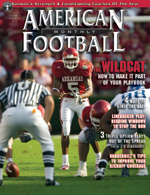Article CategoriesAFM Magazine
|
Letter from AFMby: John GallupEditor and Publisher © More from this issue While Tim Tebow lay motionless on the turf after suffering a concussion against Kentucky last September, Gator Nation held its breath. Tebow’s injury, caused by a severe blow to the head during a sack, put him in the hospital overnight and sidelined him from practice, television and video games for over a week. The good news for Gator fans was that Tebow benefited from a bye week and, with rest, recovered in time to lead Florida to a 10-3 win at LSU just two weeks after his injury.
|
|
|||||||
| HOME |
MAGAZINE |
SUBSCRIBE | ONLINE COLUMNISTS | COACHING VIDEOS |
Copyright 2025, AmericanFootballMonthly.com
All Rights Reserved





